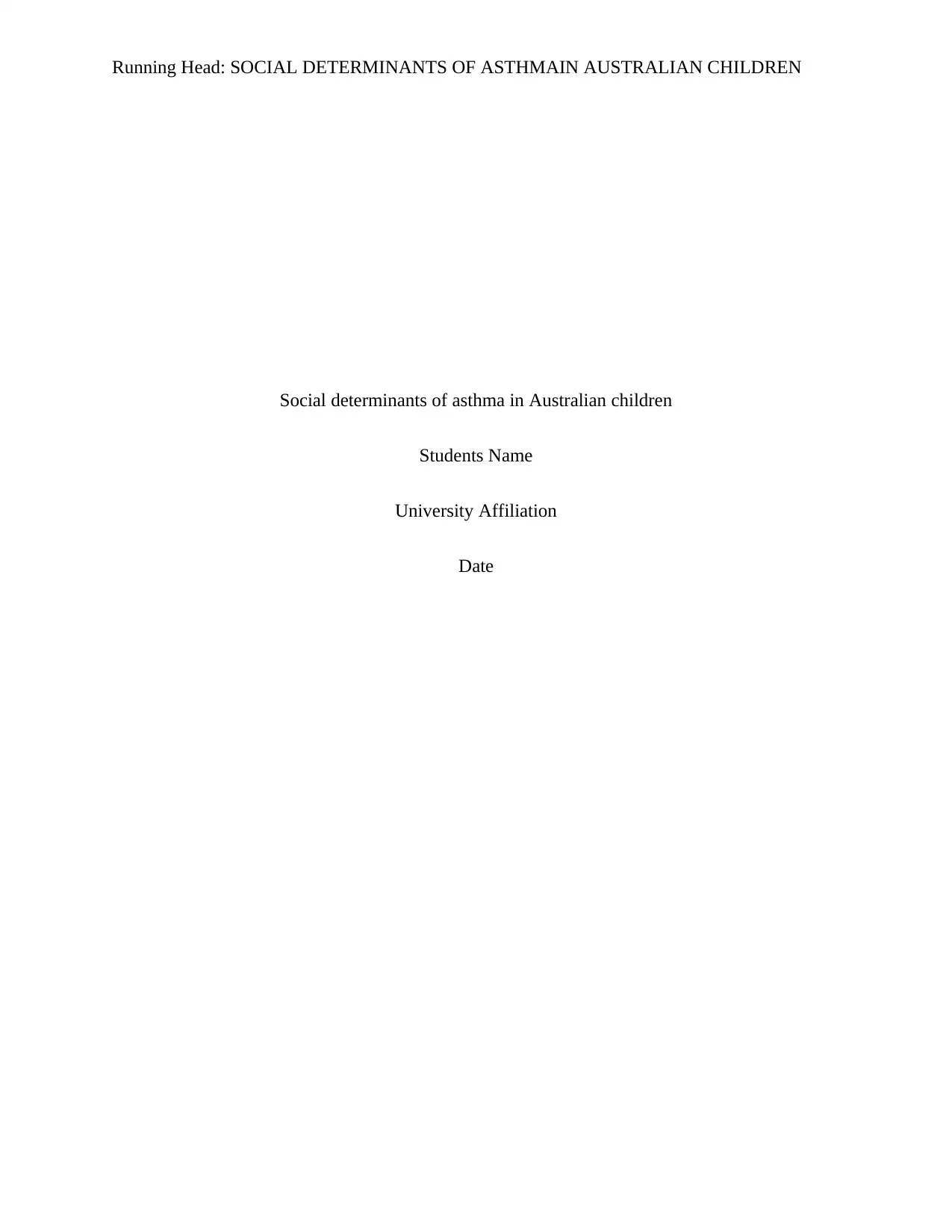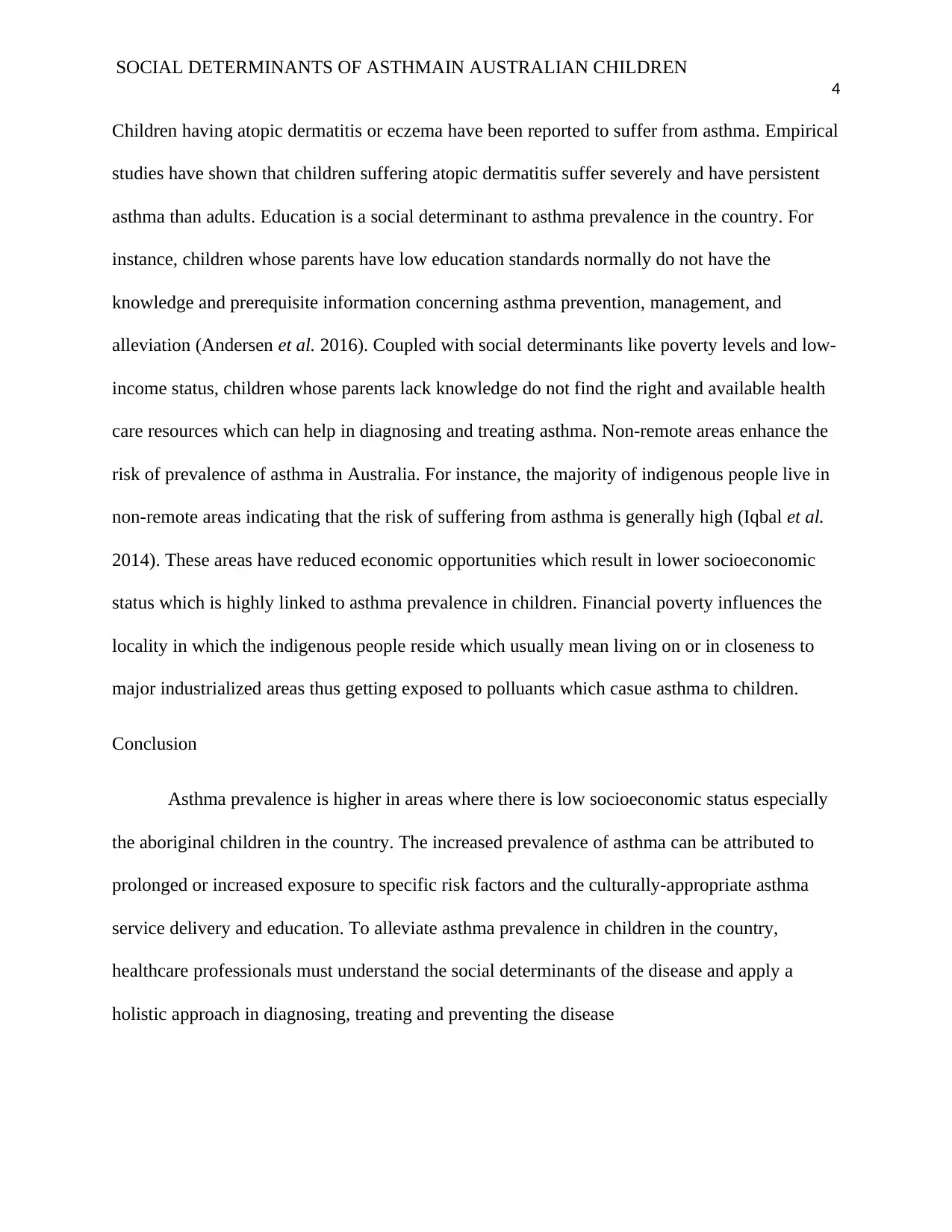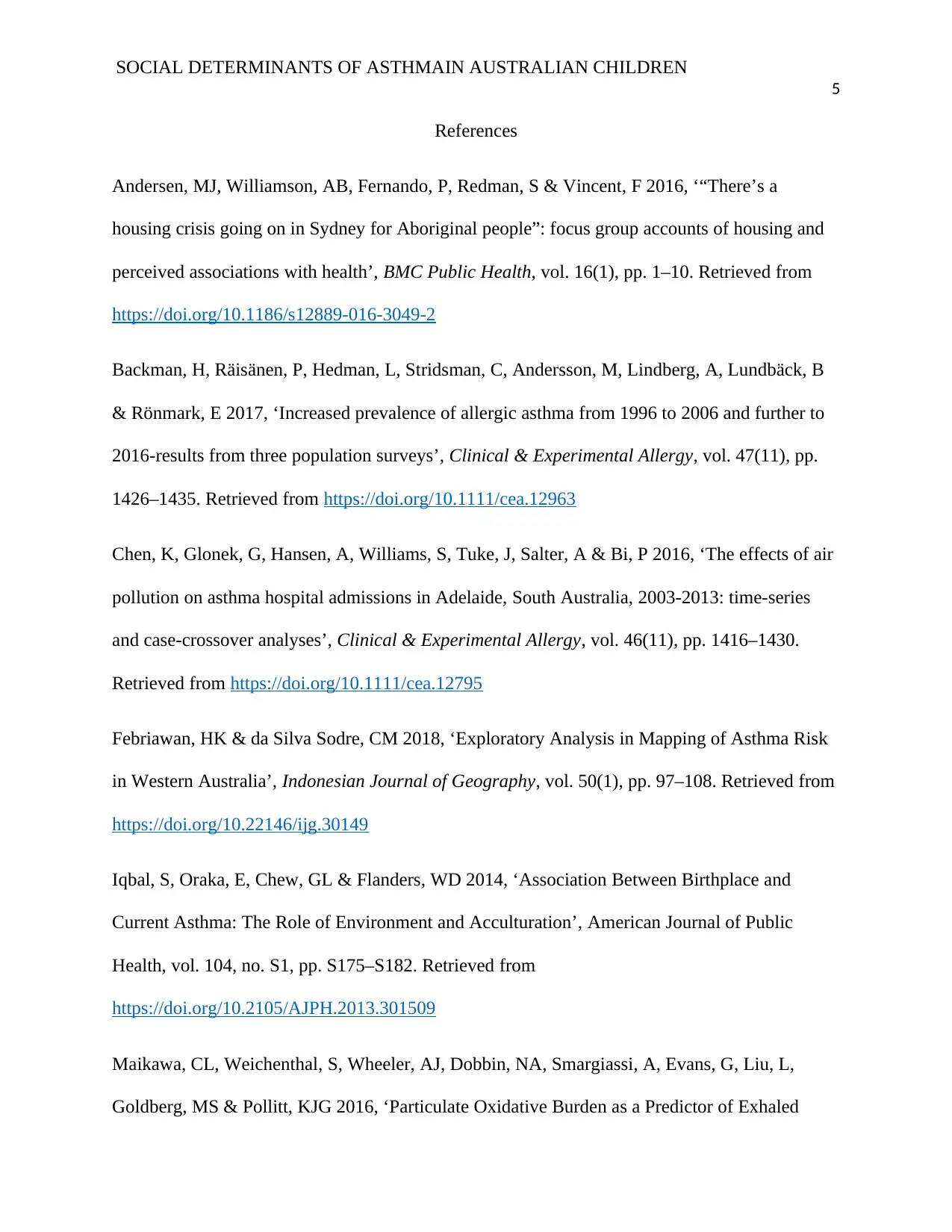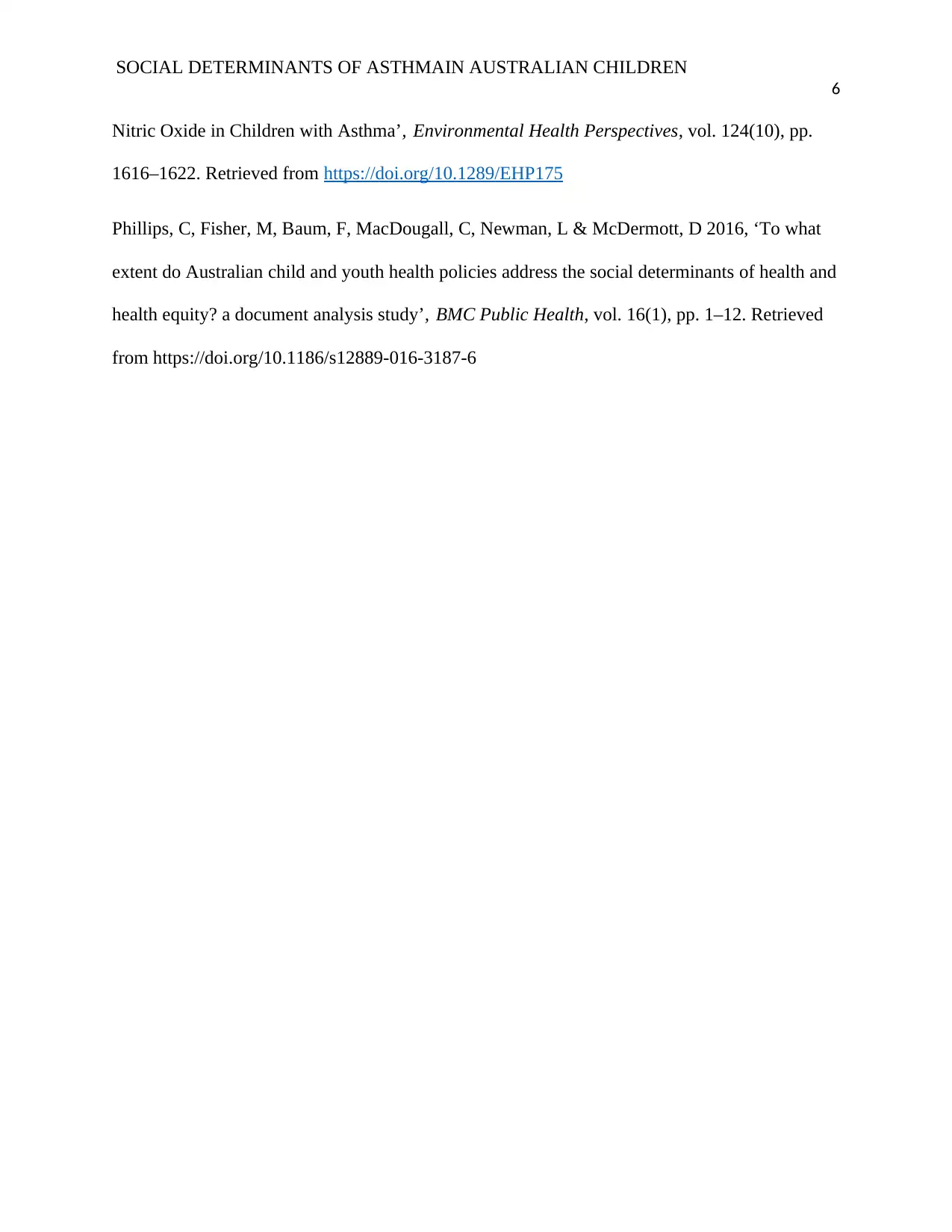Social Determinants of Asthma in Australian Children: A Report
VerifiedAdded on 2023/04/07
|6
|1230
|497
Report
AI Summary
This report delves into the social determinants of asthma among Australian children, highlighting asthma as a national health priority. The study examines the prevalence of asthma, particularly in children aged 10-15 years, and its correlation with socioeconomic factors. It explores how factors like income, education, and living conditions influence asthma rates. The report emphasizes the importance of understanding these determinants to improve asthma management and prevention strategies, especially among indigenous populations. It also discusses the impact of environmental factors, genetic predisposition, and access to healthcare resources. The report concludes by advocating for a holistic approach to address asthma prevalence, considering the complex interplay of social determinants and health outcomes. The report references several studies and provides a comprehensive overview of the issue.

Running Head: SOCIAL DETERMINANTS OF ASTHMAIN AUSTRALIAN CHILDREN
Social determinants of asthma in Australian children
Students Name
University Affiliation
Date
Social determinants of asthma in Australian children
Students Name
University Affiliation
Date
Paraphrase This Document
Need a fresh take? Get an instant paraphrase of this document with our AI Paraphraser

SOCIAL DETERMINANTS OF ASTHMAIN AUSTRALIAN CHILDREN
2
Social determinants of asthma in children
Introduction
Asthma has been declared as a National Health urgency area not only for the Australian
government but also for other countries. This is because asthma is a chronic health condition
with a important impact on the public and has well-defined interventions which have the
potential of reducing its impacts on the community and individuals. The paper will discuss
asthma as an Australian health priority and the social determinants of asthma especially in
children who are aged between 10 and 15 years.
Prevalence of Asthma in children in Australia
Based on the Australian Health statistics of 2012-2013, among the children aged between
0-14, asthma is prevalent in males while among the individuals aged 15 years and over
((Backman et al. 2017), it is more prevalent in females. In the country around 3 million people
have asthma while in children aged 5-14 years, it is one of the leading causes of total burden
(Backman et al. 2017). In general children from poorer economic or social circumstances are
normally at greater risk of poor health, live shorter lives and have higher rates of death,
disability, and illness as compared to those who are more advantaged in the society. In 2014-
2015, there were about 40000 hospitalizations where asthma was the major diagnosis, that is,
175 cases per 100000 population. children who were aged 15 years were more likely to be
diagnosed with asthma, that is, 460 cases per 100000 population as compared to those who were
aged 15 years and over (Backman et al. 2017). Traditionally, individual indicators like income,
occupation, and education have been used to describe the socioeconomic status of the people.
Children who are exposed to unsafe and unhealthy living standards in their early childhood years
2
Social determinants of asthma in children
Introduction
Asthma has been declared as a National Health urgency area not only for the Australian
government but also for other countries. This is because asthma is a chronic health condition
with a important impact on the public and has well-defined interventions which have the
potential of reducing its impacts on the community and individuals. The paper will discuss
asthma as an Australian health priority and the social determinants of asthma especially in
children who are aged between 10 and 15 years.
Prevalence of Asthma in children in Australia
Based on the Australian Health statistics of 2012-2013, among the children aged between
0-14, asthma is prevalent in males while among the individuals aged 15 years and over
((Backman et al. 2017), it is more prevalent in females. In the country around 3 million people
have asthma while in children aged 5-14 years, it is one of the leading causes of total burden
(Backman et al. 2017). In general children from poorer economic or social circumstances are
normally at greater risk of poor health, live shorter lives and have higher rates of death,
disability, and illness as compared to those who are more advantaged in the society. In 2014-
2015, there were about 40000 hospitalizations where asthma was the major diagnosis, that is,
175 cases per 100000 population. children who were aged 15 years were more likely to be
diagnosed with asthma, that is, 460 cases per 100000 population as compared to those who were
aged 15 years and over (Backman et al. 2017). Traditionally, individual indicators like income,
occupation, and education have been used to describe the socioeconomic status of the people.
Children who are exposed to unsafe and unhealthy living standards in their early childhood years

SOCIAL DETERMINANTS OF ASTHMAIN AUSTRALIAN CHILDREN
3
are likely to become primed for poor health. Children who live in socioeconomically
disadvantaged areas suffer the brunt of cardiovascular diseases like asthma. Normally they are
exposed to greater direct physical experiences and challenges and emotional stressors like
domestic instability, family conflict, etc. For instance, take a child whose parents live in a ‘poor’
neighborhood. The parents can be having stressful jobs; their home is situated near transportation
or industrial sites which cause air pollution (Maikawa et al. 2016).
Biology, genetic endowment, Education and asthma
Health determinants are the features which influence how likely people stay healthy or
become injured or ill. There are three major determinants of health, that is, behavioral risk
factors, biomedical risk factors, and social determinants of health (Phillips et al. 2016). World
Health Organization describes social determinants of health is defined as the conditions in which
individuals live, grow, age, and work as well as the systems established to deal with diseases and
illness. Thus, the situations in which individuals live are shaped by economic, social, and
political factors (Chen et al. 2016). The situations in which individuals work are born or live are
the key most vital determinant of ill health or good health. Uncontrollable and unpredictable
situations exacerbate the stress level of the child, which in turn, consequently affects how the
genes of the child are expressed. The socially established health status has life-long impacts on
the wellbeing of the child. The poor like the indigenous Australian children have been reported
to suffer from asthma more than their non-indigenous children. For instance, the prevalence of
asthma is higher among indigenous children (16%) than in non-indigenous children (14%). It is
believed that most of the asthma cases in Australia are hereditary (Febriawan & da Silva Sodre,
2018). Most children suffer from atopy which is the tendency to develop asthma in the country,
thus, causing an increased sensitivity to some allergens especially those in the air and food.
3
are likely to become primed for poor health. Children who live in socioeconomically
disadvantaged areas suffer the brunt of cardiovascular diseases like asthma. Normally they are
exposed to greater direct physical experiences and challenges and emotional stressors like
domestic instability, family conflict, etc. For instance, take a child whose parents live in a ‘poor’
neighborhood. The parents can be having stressful jobs; their home is situated near transportation
or industrial sites which cause air pollution (Maikawa et al. 2016).
Biology, genetic endowment, Education and asthma
Health determinants are the features which influence how likely people stay healthy or
become injured or ill. There are three major determinants of health, that is, behavioral risk
factors, biomedical risk factors, and social determinants of health (Phillips et al. 2016). World
Health Organization describes social determinants of health is defined as the conditions in which
individuals live, grow, age, and work as well as the systems established to deal with diseases and
illness. Thus, the situations in which individuals live are shaped by economic, social, and
political factors (Chen et al. 2016). The situations in which individuals work are born or live are
the key most vital determinant of ill health or good health. Uncontrollable and unpredictable
situations exacerbate the stress level of the child, which in turn, consequently affects how the
genes of the child are expressed. The socially established health status has life-long impacts on
the wellbeing of the child. The poor like the indigenous Australian children have been reported
to suffer from asthma more than their non-indigenous children. For instance, the prevalence of
asthma is higher among indigenous children (16%) than in non-indigenous children (14%). It is
believed that most of the asthma cases in Australia are hereditary (Febriawan & da Silva Sodre,
2018). Most children suffer from atopy which is the tendency to develop asthma in the country,
thus, causing an increased sensitivity to some allergens especially those in the air and food.
⊘ This is a preview!⊘
Do you want full access?
Subscribe today to unlock all pages.

Trusted by 1+ million students worldwide

SOCIAL DETERMINANTS OF ASTHMAIN AUSTRALIAN CHILDREN
4
Children having atopic dermatitis or eczema have been reported to suffer from asthma. Empirical
studies have shown that children suffering atopic dermatitis suffer severely and have persistent
asthma than adults. Education is a social determinant to asthma prevalence in the country. For
instance, children whose parents have low education standards normally do not have the
knowledge and prerequisite information concerning asthma prevention, management, and
alleviation (Andersen et al. 2016). Coupled with social determinants like poverty levels and low-
income status, children whose parents lack knowledge do not find the right and available health
care resources which can help in diagnosing and treating asthma. Non-remote areas enhance the
risk of prevalence of asthma in Australia. For instance, the majority of indigenous people live in
non-remote areas indicating that the risk of suffering from asthma is generally high (Iqbal et al.
2014). These areas have reduced economic opportunities which result in lower socioeconomic
status which is highly linked to asthma prevalence in children. Financial poverty influences the
locality in which the indigenous people reside which usually mean living on or in closeness to
major industrialized areas thus getting exposed to polluants which casue asthma to children.
Conclusion
Asthma prevalence is higher in areas where there is low socioeconomic status especially
the aboriginal children in the country. The increased prevalence of asthma can be attributed to
prolonged or increased exposure to specific risk factors and the culturally-appropriate asthma
service delivery and education. To alleviate asthma prevalence in children in the country,
healthcare professionals must understand the social determinants of the disease and apply a
holistic approach in diagnosing, treating and preventing the disease
4
Children having atopic dermatitis or eczema have been reported to suffer from asthma. Empirical
studies have shown that children suffering atopic dermatitis suffer severely and have persistent
asthma than adults. Education is a social determinant to asthma prevalence in the country. For
instance, children whose parents have low education standards normally do not have the
knowledge and prerequisite information concerning asthma prevention, management, and
alleviation (Andersen et al. 2016). Coupled with social determinants like poverty levels and low-
income status, children whose parents lack knowledge do not find the right and available health
care resources which can help in diagnosing and treating asthma. Non-remote areas enhance the
risk of prevalence of asthma in Australia. For instance, the majority of indigenous people live in
non-remote areas indicating that the risk of suffering from asthma is generally high (Iqbal et al.
2014). These areas have reduced economic opportunities which result in lower socioeconomic
status which is highly linked to asthma prevalence in children. Financial poverty influences the
locality in which the indigenous people reside which usually mean living on or in closeness to
major industrialized areas thus getting exposed to polluants which casue asthma to children.
Conclusion
Asthma prevalence is higher in areas where there is low socioeconomic status especially
the aboriginal children in the country. The increased prevalence of asthma can be attributed to
prolonged or increased exposure to specific risk factors and the culturally-appropriate asthma
service delivery and education. To alleviate asthma prevalence in children in the country,
healthcare professionals must understand the social determinants of the disease and apply a
holistic approach in diagnosing, treating and preventing the disease
Paraphrase This Document
Need a fresh take? Get an instant paraphrase of this document with our AI Paraphraser

SOCIAL DETERMINANTS OF ASTHMAIN AUSTRALIAN CHILDREN
5
References
Andersen, MJ, Williamson, AB, Fernando, P, Redman, S & Vincent, F 2016, ‘“There’s a
housing crisis going on in Sydney for Aboriginal people”: focus group accounts of housing and
perceived associations with health’, BMC Public Health, vol. 16(1), pp. 1–10. Retrieved from
https://doi.org/10.1186/s12889-016-3049-2
Backman, H, Räisänen, P, Hedman, L, Stridsman, C, Andersson, M, Lindberg, A, Lundbäck, B
& Rönmark, E 2017, ‘Increased prevalence of allergic asthma from 1996 to 2006 and further to
2016-results from three population surveys’, Clinical & Experimental Allergy, vol. 47(11), pp.
1426–1435. Retrieved from https://doi.org/10.1111/cea.12963
Chen, K, Glonek, G, Hansen, A, Williams, S, Tuke, J, Salter, A & Bi, P 2016, ‘The effects of air
pollution on asthma hospital admissions in Adelaide, South Australia, 2003-2013: time-series
and case-crossover analyses’, Clinical & Experimental Allergy, vol. 46(11), pp. 1416–1430.
Retrieved from https://doi.org/10.1111/cea.12795
Febriawan, HK & da Silva Sodre, CM 2018, ‘Exploratory Analysis in Mapping of Asthma Risk
in Western Australia’, Indonesian Journal of Geography, vol. 50(1), pp. 97–108. Retrieved from
https://doi.org/10.22146/ijg.30149
Iqbal, S, Oraka, E, Chew, GL & Flanders, WD 2014, ‘Association Between Birthplace and
Current Asthma: The Role of Environment and Acculturation’, American Journal of Public
Health, vol. 104, no. S1, pp. S175–S182. Retrieved from
https://doi.org/10.2105/AJPH.2013.301509
Maikawa, CL, Weichenthal, S, Wheeler, AJ, Dobbin, NA, Smargiassi, A, Evans, G, Liu, L,
Goldberg, MS & Pollitt, KJG 2016, ‘Particulate Oxidative Burden as a Predictor of Exhaled
5
References
Andersen, MJ, Williamson, AB, Fernando, P, Redman, S & Vincent, F 2016, ‘“There’s a
housing crisis going on in Sydney for Aboriginal people”: focus group accounts of housing and
perceived associations with health’, BMC Public Health, vol. 16(1), pp. 1–10. Retrieved from
https://doi.org/10.1186/s12889-016-3049-2
Backman, H, Räisänen, P, Hedman, L, Stridsman, C, Andersson, M, Lindberg, A, Lundbäck, B
& Rönmark, E 2017, ‘Increased prevalence of allergic asthma from 1996 to 2006 and further to
2016-results from three population surveys’, Clinical & Experimental Allergy, vol. 47(11), pp.
1426–1435. Retrieved from https://doi.org/10.1111/cea.12963
Chen, K, Glonek, G, Hansen, A, Williams, S, Tuke, J, Salter, A & Bi, P 2016, ‘The effects of air
pollution on asthma hospital admissions in Adelaide, South Australia, 2003-2013: time-series
and case-crossover analyses’, Clinical & Experimental Allergy, vol. 46(11), pp. 1416–1430.
Retrieved from https://doi.org/10.1111/cea.12795
Febriawan, HK & da Silva Sodre, CM 2018, ‘Exploratory Analysis in Mapping of Asthma Risk
in Western Australia’, Indonesian Journal of Geography, vol. 50(1), pp. 97–108. Retrieved from
https://doi.org/10.22146/ijg.30149
Iqbal, S, Oraka, E, Chew, GL & Flanders, WD 2014, ‘Association Between Birthplace and
Current Asthma: The Role of Environment and Acculturation’, American Journal of Public
Health, vol. 104, no. S1, pp. S175–S182. Retrieved from
https://doi.org/10.2105/AJPH.2013.301509
Maikawa, CL, Weichenthal, S, Wheeler, AJ, Dobbin, NA, Smargiassi, A, Evans, G, Liu, L,
Goldberg, MS & Pollitt, KJG 2016, ‘Particulate Oxidative Burden as a Predictor of Exhaled

SOCIAL DETERMINANTS OF ASTHMAIN AUSTRALIAN CHILDREN
6
Nitric Oxide in Children with Asthma’, Environmental Health Perspectives, vol. 124(10), pp.
1616–1622. Retrieved from https://doi.org/10.1289/EHP175
Phillips, C, Fisher, M, Baum, F, MacDougall, C, Newman, L & McDermott, D 2016, ‘To what
extent do Australian child and youth health policies address the social determinants of health and
health equity? a document analysis study’, BMC Public Health, vol. 16(1), pp. 1–12. Retrieved
from https://doi.org/10.1186/s12889-016-3187-6
6
Nitric Oxide in Children with Asthma’, Environmental Health Perspectives, vol. 124(10), pp.
1616–1622. Retrieved from https://doi.org/10.1289/EHP175
Phillips, C, Fisher, M, Baum, F, MacDougall, C, Newman, L & McDermott, D 2016, ‘To what
extent do Australian child and youth health policies address the social determinants of health and
health equity? a document analysis study’, BMC Public Health, vol. 16(1), pp. 1–12. Retrieved
from https://doi.org/10.1186/s12889-016-3187-6
⊘ This is a preview!⊘
Do you want full access?
Subscribe today to unlock all pages.

Trusted by 1+ million students worldwide
1 out of 6
Related Documents
Your All-in-One AI-Powered Toolkit for Academic Success.
+13062052269
info@desklib.com
Available 24*7 on WhatsApp / Email
![[object Object]](/_next/static/media/star-bottom.7253800d.svg)
Unlock your academic potential
Copyright © 2020–2025 A2Z Services. All Rights Reserved. Developed and managed by ZUCOL.





